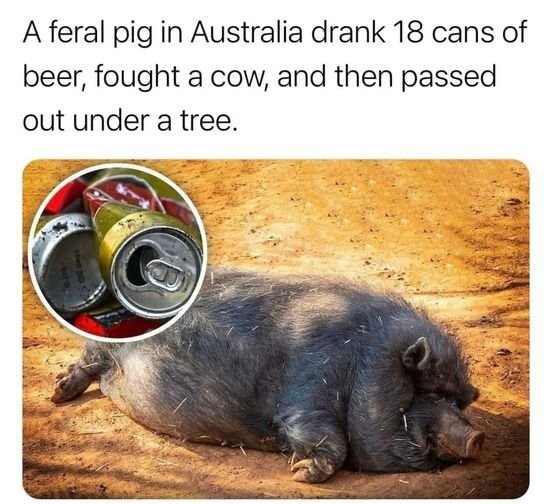-
Posts
9,540 -
Joined
-
Last visited
-
Days Won
75
Content Type
Profiles
Forums
Events
Everything posted by Buckshot Bear
-

The Canadian Thread
Buckshot Bear replied to Cold Lake Kid, SASS # 51474's topic in SASS Wire Saloon
OMG that is COLD -

The Canadian Thread
Buckshot Bear replied to Cold Lake Kid, SASS # 51474's topic in SASS Wire Saloon
It was 4°C here this morning....surely it doesn't get that cold in Canada? No one would be able to survive -
On this judgmental scale, I'm an extremely less educated individual, very disrespectful and lacking in maturity. Damn I love being me
-
I wear shorts 365 days a year and open footwear (as do a lot of Aussies) its hot and humid down here.
-
Pretty shocked to see people saying this whole thing was staged in interviews. https://www.skynews.com.au/opinion/lost-all-contact-with-reality-amanda-seales-called-out-over-claims-trump-shooting-was-staged/video/6fa4858576b9c9c7f235488b388f4efb
-
-
-
That billy can looks pretty rough, I'd much prefer to use the one below especially swinging it over my head to settle the tea leaves.
-
Australian History Daily Slang - todays word is; Billy – with story to explain Teapot (In the Outback on the fire) Picture yourself in the rugged Outback, gathered around a campfire with mates, savoring the rich aroma of freshly brewed tea. But billy tea isn’t just about the beverage itself; it’s a symbol of camaraderie and timeless traditions. So grab your bush hat and prepare for an adventure into the fascinating realm of Australian slang and culture. HISTORY AND ORIGINS OF BILLY TEA Billy tea holds a rich history and deep-rooted origins in Australian culture. Dating back to the early days of colonial Australia, billy tea became a staple drink for explorers, drovers, and bushmen who needed refreshment during their relentless journeys. The term “billy” refers to a lightweight metal can or pot used for boiling water over an open fire. It was the go-to vessel for making tea in rugged outback environments where traditional teapots were impractical. As pioneers relied on this resourceful method of brewing tea, billy tea became synonymous with adventure, camaraderie, and the spirit of the Australian bush. Legend has it that swagmen (travellers carrying their belongings) would boil water in their trusty billy cans as they roamed vast landscapes seeking work and sustenance. In those times, sharing a cup of steaming billy tea around a campfire was more than just quenching one’s thirst; it fostered connection and provided comfort in an otherwise harsh environment. The tradition of billy tea grew alongside Australia’s rich pastoral history. It became an integral part of droving expeditions and stockman life as they herded livestock across vast distances. Billy can boilers often carried fragrant eucalyptus leaves or gum twigs to add extra flavor to their brews—a uniquely Australian twist on this beloved beverage. Today, while modern advancements have made boiling water easier than ever before, Australians continue to cherish the heritage of billy tea as a symbol of resilience, simplicity, and mateship. So next time you sip on your cozy cuppa down under, remember that you are carrying on a timeless tradition rooted in the tales of adventurers who found solace and companionship through their shared love for this quintessential Aussie drink.
-
-
-
Fabulous 'Iwo Jima' shot of President Trump, that will certainly be an historical photo for the archives of history.
-
Would Trump have been wearing a ballistic vest?
-
Or you can just be a pig and live in a sty.
-

ASSASINATION ATTEMPT AT TRUMP RALLY
Buckshot Bear replied to Texas Jack Black's topic in SASS Wire Saloon
This is going to 'rocket man' him on the polls. -

Burial with honors for the Red Baron
Buckshot Bear replied to Marshal Mo Hare, SASS #45984's topic in SASS Wire Saloon
-
Wow.....the scoundrel walked.
-
-
COOKING DAMPER’ - 1958 A Drover’s wife cooking damper, Ursino Bore, 1958. While on the road with a mob of 3,700 Merino ewes between Tibooburra and Coonamble, Mavis helped cook for the family droving team
-
-
Jensen 20g Steam Engine Driven Leonardo DaVinci Mechanical Drum Thought this might interest some of you pards this was a lot of fun to make and to modify, the mods made the kit a real model or toy steam engine accessory. Its extremely loud in use! It was easy to spray paint the kit before assembly and to make the drive pulley on my metal lathe out of aluminum and the drive belt is O ring super glued together. The timber plinth I routed is just plain stained pine and three coats of marine spar varnish. Its never going to be a 'musical' instrument! I need to run the belt through one of the transmissions that I have machined up over the years, this was just a test to see that it all held together.
-
LOL
-
-
-
‘AUSTRALIA’S LAST CONVICT SHIP’ -1868 The Blackwall Frigate Hougoumont, unloads the final 279 convicts in WA. Australian Geographic. IT’S A WARM SUMMER’S day on 9 January 1868 in Fremantle, Western Australia, and the last convict ship to transport prisoners to Australia is just coming in to port. The ship had departed Portsmouth on the 12 October, with 280 convicts and 108 passengers, helmed by William Cozens. The complement of convicts included 62 Fenians, including 17 from the military, a contingent which contravened an agreement between the United Kingdom and Western Australia, leading to a brief panic in Fremantle. The inclusion of military Fenians also flouted the UK’s unwritten policy not to transport military prisoners. Upon seeing Australia for the first time, the prisoners no doubt feel a frisson of excitement mingled with a little fear, despite their sentences – compared to the gallows, Australia isn’t looking too bad. It has been a relatively uneventful voyage – only one convict has died in the 89 days the ship has been at sea – but an unusual one; due to the reasonably high number of literate convicts from the complement of political prisoners from the Fenian Rising the previous year, the voyage even had its own newspaper: The Wild Goose, of which all seven handwritten issues survive in the State Library of New South Wales. Babette Smith, historian and author of Australia’s Birthstain: the startling legacy of the convict era, says that transportation wasn’t as bad as its legacy decries. “Most of the prisoners got access to medical care and to meat,” she says. “And their children were often markedly taller and stronger.” Some crimes were even carefully premeditated to warrant transportation with a lenient sentence as an escape from poverty in Britain, or to join family members. Due to the high literacy rate amongst the prisoners, the voyage produced a number of diaries and accounts, notably those of Denis Cashman and Thomas McCarthy Fennell, and John Boyle O’Reilly’s letters. This final complement of convicts signalled the end of a significant period in Australian history. Between 1788 and 1868, more than 165,000 convicts were transported to Australia, of which 10,000 were sent to Western Australia. By the time penal transportation ended, Australia had grown to a population of more than 1 million – compared to just 30,000 in 1821 – and it was finally large enough to be autonomous, to sustain itself and grow.






















